How To Get Good Backlinks: A Step-by-Step Guide
Topic: SEO
Published:
Written by: Bernard Huang
Imagine this: It’s 2011. Everyone is singing Adele’s “Rolling in the Deep” and talking about the upcoming royal wedding on Tumblr.
But elsewhere on the internet, some companies are finding out their strategies to reach the top of the search results aren’t exactly paying off.
Because even back in 2011 — we’re talking iPhone 4 days here — Google was penalizing brands like JCPenney for unethical link-building techniques. But what exactly was the company doing?
According to this now-ancient article from The New York Times, JCPenney was allegedly paying to have thousands of links that redirected to its website from all over the web. And for a while, it worked.
Searches for “skinny jeans” or even “furniture” would redirect searchers back to JCPenney's website for months. But then Google decided the brand had crossed the line into unethical black-hat search engine optimization (SEO) and gave it a 90-day timeout that effectively wiped it from search results for months.
Link-building struggles have a long history for all sizes of businesses. But if multibillion-dollar corporations struggle with their SEO game, what are smaller brands and websites to do?
Learning how to get good backlinks is a delicate, ever-changing process. It’s a rewarding long-term strategy, but it also requires some hard work.
In this step-by-step guide, we’ll go over what backlinks are, how they factor into your SEO success, and how to get good backlinks without getting in trouble with search engines.
How to Get High-Quality and Good Backlinks
Imagine your perfect backlink. It probably comes from a website you’re already familiar with that operates in your area of expertise.
It’s also going to be a source you respect. And to be honest, you might even be a little bit jealous of the success of this ideal backlink website.
Add all this together, and you have the recipe for a high-quality backlink. It has good domain authority, publishes content related to yours, and is a source you’d feel proud to be connected to.
To figure out how to get good backlinks, you first need to know what makes them good. Let’s break down the elements that make up a high-quality link.
The website is relevant
Backlinks from random websites have a lower chance of being relevant to your content.
For example, if you run a blog discussing the best motorcycles, a backlink from a motorcycle helmet blog would be much more relevant than a backlink from a biochemistry website. If a link source is a bit random, it might confuse both search engines and readers. Additionally, a relevant website might include your link on a resource page, which is a curated list of useful links and resources, helping you secure valuable backlinks.
The source is reputable
You also want your backlinks to be reputable. This means they come from a trustworthy source, which looks different for every niche.
For example, the Centers for Disease Control and Prevention (CDC) is considered trustworthy for medical information but might not be the most authoritative website for weather information. You want to consider the topical authority of the source for the specific context you’re covering.
In general, you should aim to follow Google’s Quality Rater Guidelines, particularly the E-E-A-T section guidelines.
E-E-A-T stands for:
Experience
Expertise
Authority
Trustworthiness
These guidelines help Google assess the quality of a website. At the very bottom, you have the lowest-quality websites. These are often full of misinformation or outright harmful info, and they do not perform well. They may even be deindexed if bad enough.
Reputable sources include blogs with content your audience finds helpful, websites your audience is familiar with, and high-domain authority sources. Check that these websites get a regular amount of traffic, too.
Generally, high-quality niche websites don’t just publish random content. They have a narrowly defined subject focus, and they offer on-topic value for the target reader.
Reach out to the site owner to secure backlinks from reputable sources.
The website follows linking best practices
A backlink should come from a reputable and relevant source, but you want the link to follow SEO best practices, too.
Ideally, you’re already using contextually relevant anchor text on your internal links (for example, not using “click here”), and you want to take the same approach when getting backlinks. Following SEO best practices is crucial for effective link building strategies.
The website shows trustworthiness
Try using Moz’s Link Explorer tool to check the quality of websites linking to the entire domain. You’ll see a spam score that shows the overall quality of the website.
Generally, choosing websites with a spam score of 30% or less is a good idea, according to Moz. Those websites are likely adding value for their readers.
You can also use a tool like Ahrefs URL Rating (UR) to check the quality of the websites linking to a specific URL. Websites are ranked from 1-100 and generally follow Google PageRank, so a higher UR will generally correspond with a more reputable website.
How to get quality backlinks
Building links by leveraging original studies and research
Look for brand mentions
Broken link building
Look to the competition
Guest blog strategically
Link back in kind
Influencer marketing
Pitch to reporters
Guest podcasting
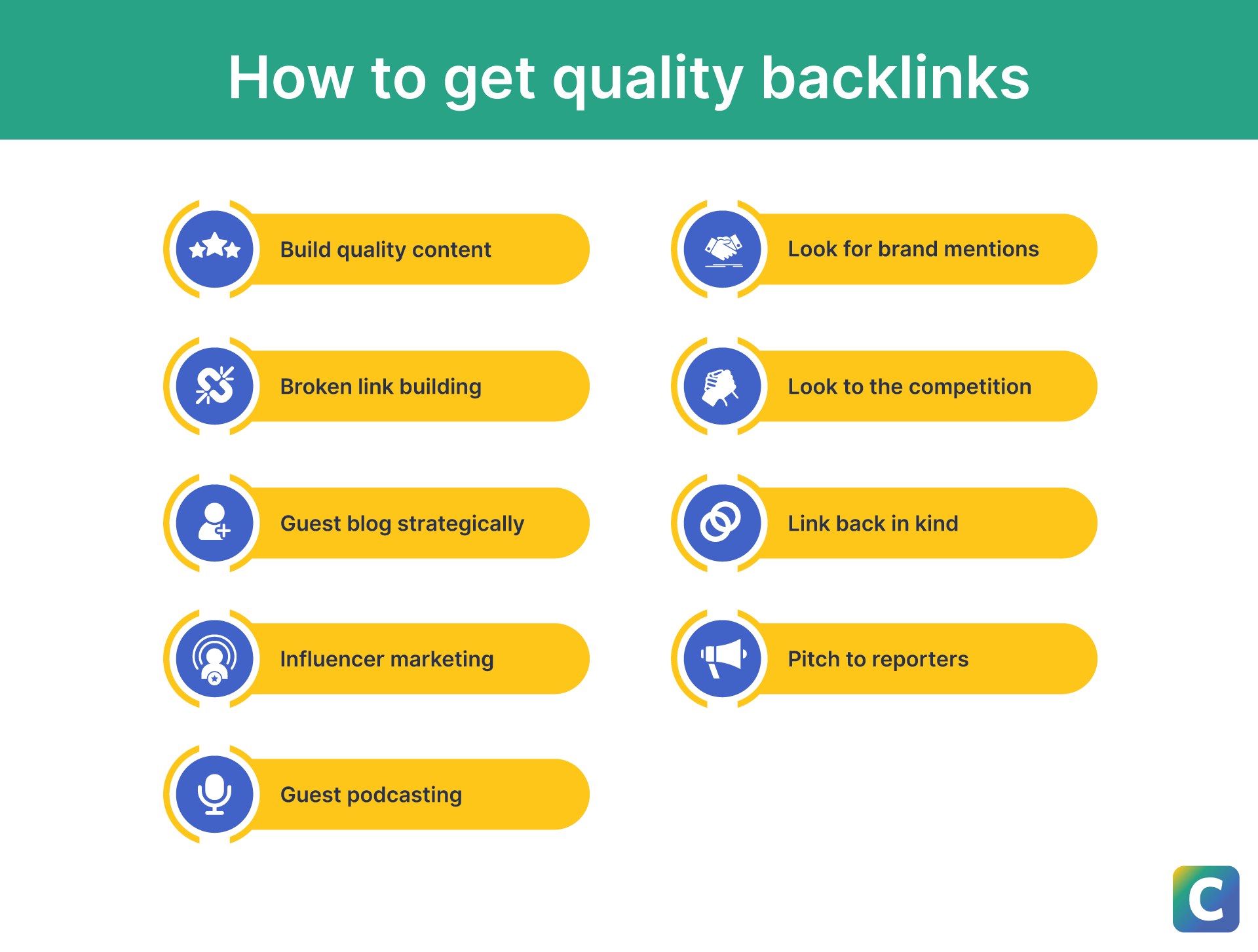
Tips for how to get quality backlinks.
Build quality content
Create content so good that it naturally attracts links. This isn’t limited to your webpages, either. Use visuals like infographics or downloads to help build backlinks, too. As Ross Hudgens describes Siege Media’s link-building strategy:
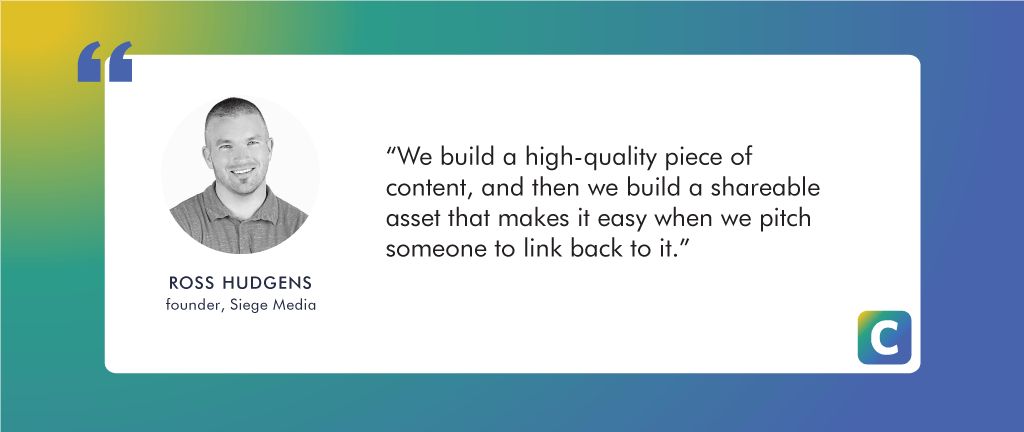
Siege Media CEO, Ross Hudgens on building quality content.
To see the results of this concept in action, take this case study in backlink building. When trying to figure out how to get high-quality backlinks, WordStream created an eye-catching infographic highlighting issues Google had run into. The image was widely shared on social media and eventually netted the company a backlink from CNN.
Look for brand mentions
Keep an eye out for brand mention opportunities. Ask websites that mention you to add a link or reach out for a mention from relevant websites.
This tactic is especially worth pursuing for established brands that may have a lot of unlinked brand mentions floating around. The key is to target unlinked brand mentions that fit specific criteria.
Say you find a website that has an article about the best keyword research tools. If your company offers a keyword research tool, but you’re not on that list, you may want to reach out and ask about including your tool in the article. The article might be due for a content refresh, so adding your link could benefit the other website, too.
Broken link building
Another similar method is to go after broken links. If you find a website with a broken external link, reach out to the owner about replacing the broken link with a relevant option of your own.
They’ll want to replace the broken link, and if your link is relevant to the subject, it could be an easy fix for them. You can use a tool like Siteliner to quickly search a domain for broken links.
This works best if you can find a specific link on a post and bring it to the website owner’s attention. If you do most of the work by thinking through most of the process for them, they may feel grateful and ready to swap out the dead link for yours.
Look to the competition
When you’re working on a strategy for how to get good backlinks, research competitor backlinks for potential niche sources to collaborate with. This will help you figure out what tactics your competitors are using so you can replicate and improve on them.
You can also look vertically and promote your content within your vertical market. This narrow industry may not have a lot of customers, but rather it caters to a very specific customer base. This may include some software programs or apps with limited appeal.
While you won’t always appeal to a wide audience, your specific target audience may be very passionate.
While analyzing competitors within your niche, you may discover online directories worth targeting. This is especially useful for local businesses, so pay attention to directories linking to your competition.
Additionally, competitors might be getting backlinks from resource pages. You can do the same by finding resource pages that list 'helpful resources' or 'useful resources' and reaching out to the site owners to include your site.
Guest blog strategically
This was the third most popular way to build backlinks in 2022, according to a poll by uSERP. 12% of SEO experts used this technique, while 16% preferred digital PR and 13% focused on content marketing.
When deciding who to write for, look for a website that overlaps your niche — and would have readers similar to your own. Once you’ve identified a good source, get in touch.
If the website has a robust blog, it may have a dedicated post on how to write for it. Follow its standards, and make sure the website hasn’t already featured the article you want to pitch. Some websites will accept a pitch alone, while others will want to see a completed draft.
You can find blogs to write for by simply doing a search on Google or using a tool like Ahrefs. To find relevant websites that may accept guest posts, enter a keyword from your niche and filter the results by page titles. You’ll then see which websites publish similar topics in your industry.
You can further filter these websites by traffic and domain rating to narrow down your list.

Ahrefs tool with potential guest posting opportunities for the keyword “content marketing.”
If you check the Author tab, you can get an idea of which websites use guest bloggers. In general, websites with many authors are more likely to accept your submission.
Link back in kind
While we don’t recommend reciprocal backlinking (which can possibly trigger a Google penalty), linking back to quality sources is helpful. This can be a win-win for you and any relevant websites. Instead of backlinking each other directly, it may work better if you link back with a different website you run.
But remember, as per Google’s spam policies, link requests are considered spam. Still, you should include quality backlinks in your own posts naturally to verify claims and offer additional information.
Link to websites you read and believe your readers would find value in. You can always send an outreach email to the website owner to let them know you found their article helpful and are linking to it. You could also tell them about your website. If they like your content, they may decide to link back.
Influencer marketing
This will vary depending on your industry, but influencer marketing could be a good idea if you have a consumer product. Part of influencer marketing involves influencers trying products and discussing them with their followers.
Typically, influencers are required to provide a link as part of your agreement. Just be aware that for a link with sponsored content, you need to disclose it, typically by marking it with either a rel=“ugc” or rel=“sponsored” tag. This helps search engines categorize links.
Influencer Marketing Hub’s 2023 report found a strong preference for working with small niche influencers, with 69% of brands preferring to work with nano- or micro-influencers over celebrities or macro-influencers.
There are influencers for thousands of niches, and working with a few could help you build backlinks and boost your social media presence.
Pitch to reporters
Pitch answers to reporters for topics in your area of expertise to potentially gain useful backlinks. There are several websites you can use for these types of pitches, such as:
While not all pitches will result in a feature or backlink, it’s a common practice to add a link to a source you’ve used to help readers.
Guest podcasting
Create a podcast guesting strategy. Many podcast hosts need guests or experts, and working together could benefit you since guesting typically comes with a backlink.
You may act as a guest host for a whole show or only sit in for a segment. You should plan for it to take at least an hour to conduct the interview.
What to be aware of when requesting backlinks
Reaching out for backlinks can be a bit intimidating, but following general internet etiquette will make it a more seamless experience.
Be polite — even if you’re asking a webmaster to stop linking to you. Try to give others the benefit of the doubt. They might not even realize their backlink strategy could be hurting both of you.
The websites you’re asking for backlinks from will also want to build up a network of quality websites. You might find that some sources will be happy to link to multiple posts you’ve made if your content offers their readers value.
You can use a template to craft your backlink requests, but remember to personalize your outreach. There’s nothing worse than getting a request to “whom it may concern” that could have been pitched to hundreds of other site owners. Certainly, there’s nothing less compelling to act on than a mass cold email with zero personalization.
Here’s an example:
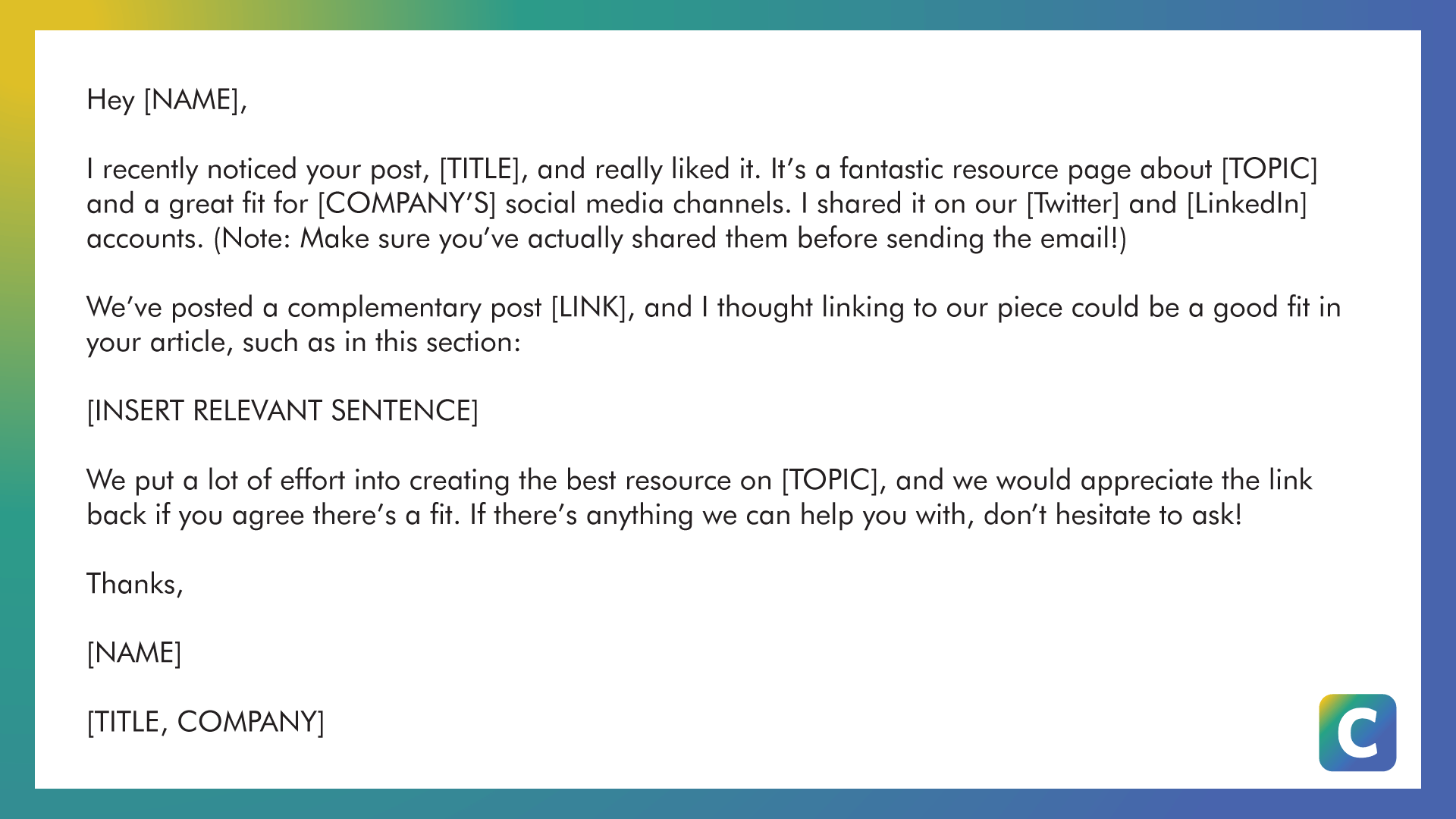
Example of a backlink request email.
List of backlink checkers
Remember how we mentioned that back in the Wild West days of the internet, search marketers used to get their backlinks from almost anywhere? These days, Google discourages this practice, partially by penalizing website owners who build large quantities of low-quality backlinks.
Google calls this “unnatural links to your website.” You’ll have to remove the low-quality links and submit a request for a review once you’re done. Until you fix the issue, expect lower traffic and search rankings.
You can get an idea of whether your own website is doing well with backlinks by checking if there’s an increase in your domain authority over time, if backlinks are coming from industry-relevant pages, and whether any of your backlinks are flagged as spam.
You can work on addressing these issues with a backlink checker.

Backlink Analytics by Semrush (image source).
These tools will analyze any website or specific pages linking to yours and tell you important details you need to know to assess the quality of the links. They can show the type of backlinks, the anchor text used, and the authority of the referring links:
Try out a few of the tools and compare the data they provide and look over the results critically.
Earning backlinks and the types of content that earn them
We’ve gone over how to get good backlinks and what to look for in the websites you want to get backlinks from, but what about optimizing your own content around them?
The best way to get backlinks is to have content worth linking to. Hudgens, CEO of Siege Media, an SEO content marketing agency, agrees.
His team has sent out thousands of link-building emails, but as he sums it up: “Focusing on the experience and quality of the site itself, very confidently, is going to drive better outcomes with that time investment as compared to reaching out manually offsite.”
Instead, his team now focuses on their content.
Here’s how to ensure your work is connecting with your audience:
Cater to your readers
A great place to start is by analyzing the search terms users enter before they reach your website. While some of these searches might be direct, others might shed new light on other topics you could cover. Google Search Console Insights offers a good overview of this.
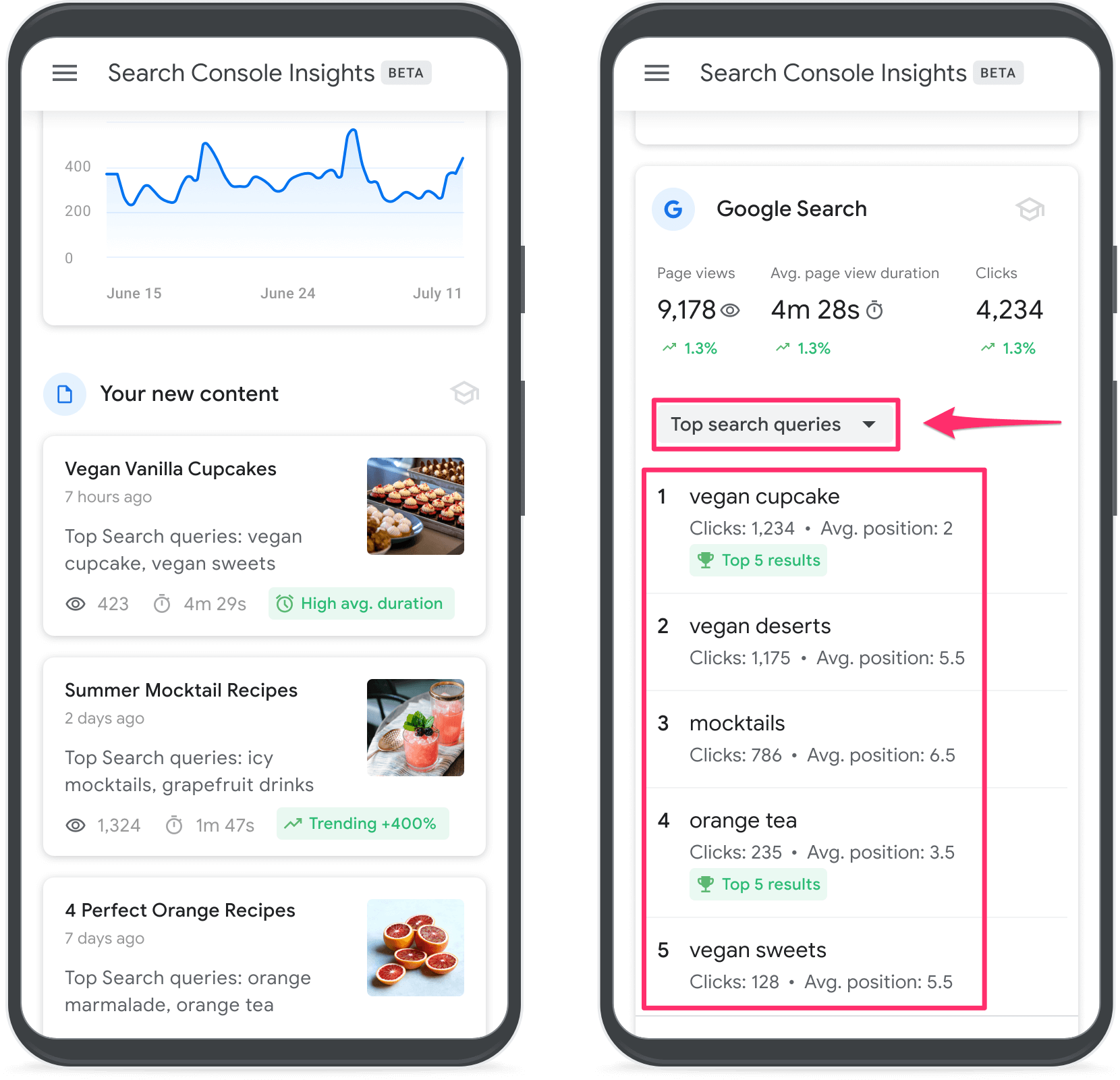
Google Search Console Insights' Top search queries.
Some of the terms may surprise you, and you can see if there’s a gap that might need filling.
Likewise, you should double-check older posts and make sure they’re still reaching the people you intend them for.
One way is by checking if your website has had any removal requests. You can check Google Search Console’s removal tab and see if any of your posts have been reported to Google. It will tell you if this is due to outdated content or a different issue.

Use Google Search Console to check if your website has been reported to Google in the past six months.
If you have outdated content that has been reported, consider giving it a refresh to get it back in front of your ideal viewers.
Offer free content
Consider offering free resources. Linking to a free guide or downloadable usually generates more interest in backlinks than regular articles. G2 analyzed the backlinks of some successful websites and found terms like “guide,” “case study,” and “statistics” came up in many of the top linked-to pages.
These items need to be high-quality and relevant. The information should also be compelling for your target audience.
In addition to e-books, you might consider investing in creating industry studies, quizzes, videos, webinars, or how-to guides.
Create lists and unique posts
Lists or roundup posts are a popular way to link to more great content, but they can also help you get backlinks.
For example, Zapier used listicles to add over five million sessions to its website. While doing this, the team also built up a network of thousands of backlinks to these posts.
Don’t forget to keep the content in these lists unique. Both the text and visuals should be your own. People usually don’t want to link to an article that covers the same thing as a dozen others.
This goes back to those Google Search Quality Guidelines. They advise users to check whether “unique, original content that is not available on other websites” is featured.
Understanding backlinks and why they are so important
A backlink comes into existence when an external website adds a link back to your website. For example, this could involve a company adding a link to a specific charity it donates to on its website. That’s a backlink for the charity.
In addition to sharing sources and information with others, backlinks help with your search PageRank, meaning they play a role in how high your content ranks in the search engine results pages (SERPs).
If a website cites your page with a link, it's probably because its team believes your content is relevant and trustworthy. That increases the likelihood of someone discovering your page while going through relevant content, like when a reader is on a similar blog post on a linking website. Building backlinks is still relevant to your SEO efforts and content optimization strategy, even if it’s not as crucial as it used to be.
According to Duy Nguyen of the Google Search team, “Backlinks as a signal has a lot less significant impact compared to when Google Search first started out many years ago.”But it’s still a key metric for many companies.
Domain authority
A big factor in backlinks' usefulness is where they come from. In general, a backlink from a referring domain with greater domain authority (DA) will carry more weight than one with low DA.
Domain authority is a popular scoring method created by Moz. A website’s ranking is based on a logarithmic scale of 1-100, in part due to the backlinks it has and the quality of those links. Moz designed this as a competitive metric benchmark, so take note that it’s not giving you an absolute ranking.
Part of your website’s DA is determined by the number of backlinks you have, so with more quality backlinks, you’ll earn a higher DA.
While it’s not an official Google ranking factor, it can help you determine how difficult ranking for certain keywords can be.
Keyword difficulty

Look up the keyword difficulty and compare it to your domain authority.
You may have seen this term used by tools like Ahrefs and Semrush, as well as a number assigned to a keyword with a logarithmic score from 0-100.
Keyword difficulty refers to how competitive the keyword is and how difficult it will be to rank highly for that term. The number shown is tied to your domain authority ranking.
So, if you’re trying to rank for the “call to action example” keyword shown above, you’ll see it has a score of 70, which Ahrefs warns could be pretty hard. It estimates you’ll need backlinks from approximately 202 websites to rank in the top 10.
Why building backlinks is essential to SEO success
Your content can be amazing, but if no one is linking to it, how will anyone know? Building backlinks plays an important role in your overall SEO strategy, and it does this in a few different ways.
It adds one more source of traffic
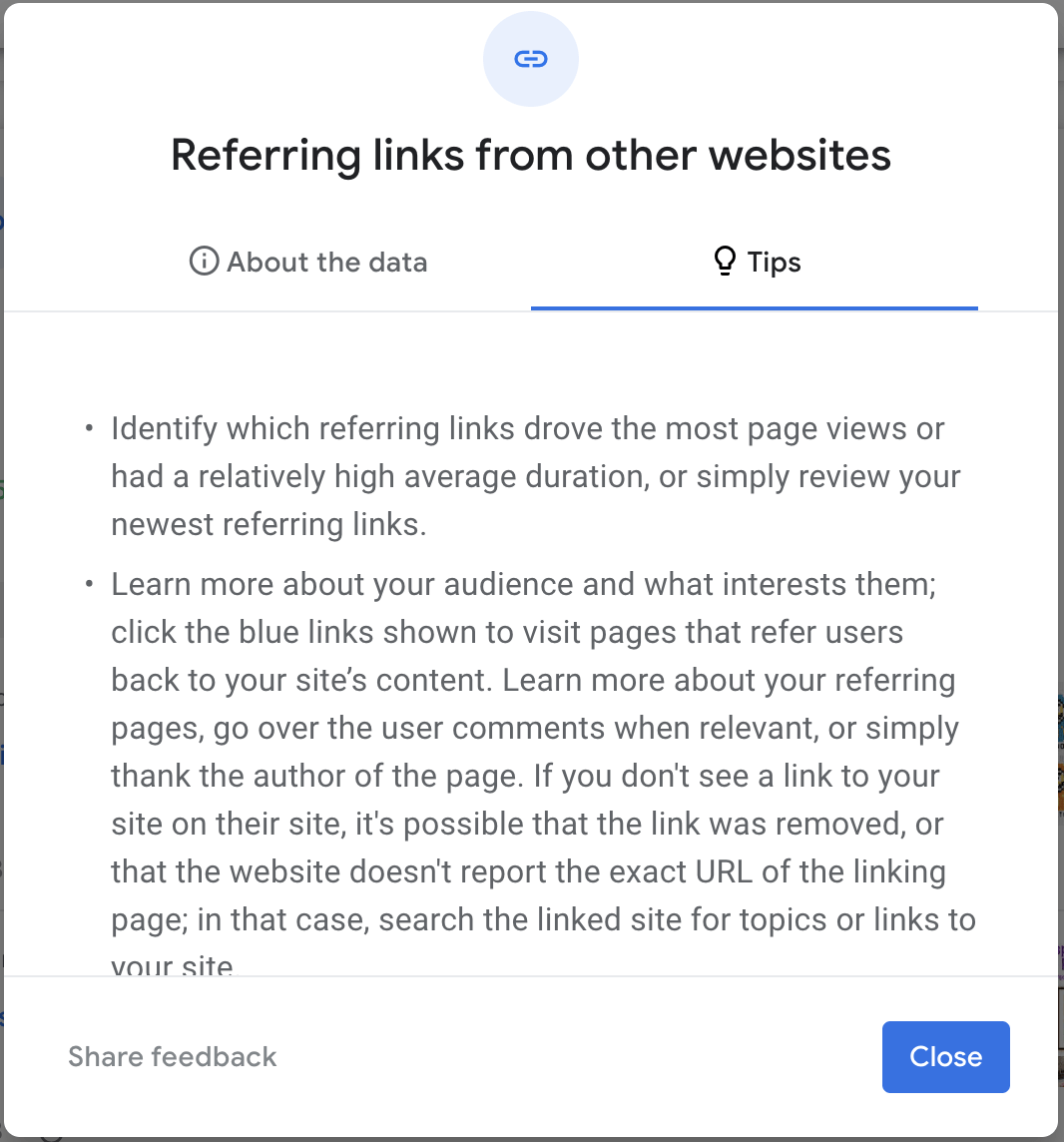
Google Search Console Insights' tips on referring links.
Organic traffic is vital to your website, but think of backlinks as an extension of that traffic. More backlinks will help you rank higher, probably leading to more visitors, so the two are intrinsically connected.
Thanks to changes in search policy, you’ll need to build these organically, too. Google updated its spam policies in December 2022, explicitly clarifying that paying for backlinks is considered spammy.
Instead, Google wants users to focus on building quality content that other websites want to share. So, backlinks should be part of your overall content marketing strategy.
We’ve mentioned using Google Search Console Insights before, but did you know it displays your new backlinks and top referral traffic from the past 28 days under the Referring links section?
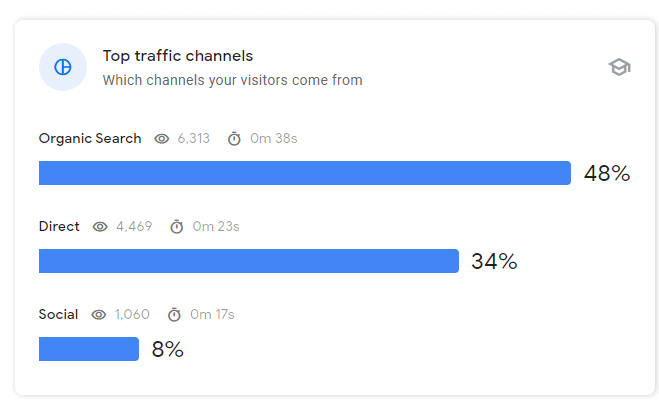
Google Search Console Insights' Top traffic channels.
To see a more complete history of your backlink performance, you can try premium SEO tools like Ahrefs and Semrush.
You can also see a more comprehensive view of your referring traffic in Google Analytics. You’ll find a breakdown of each source under the Acquisitions tab. Google details which URLs your traffic is coming from, how long those visitors are staying on your website, and how engaged they are.
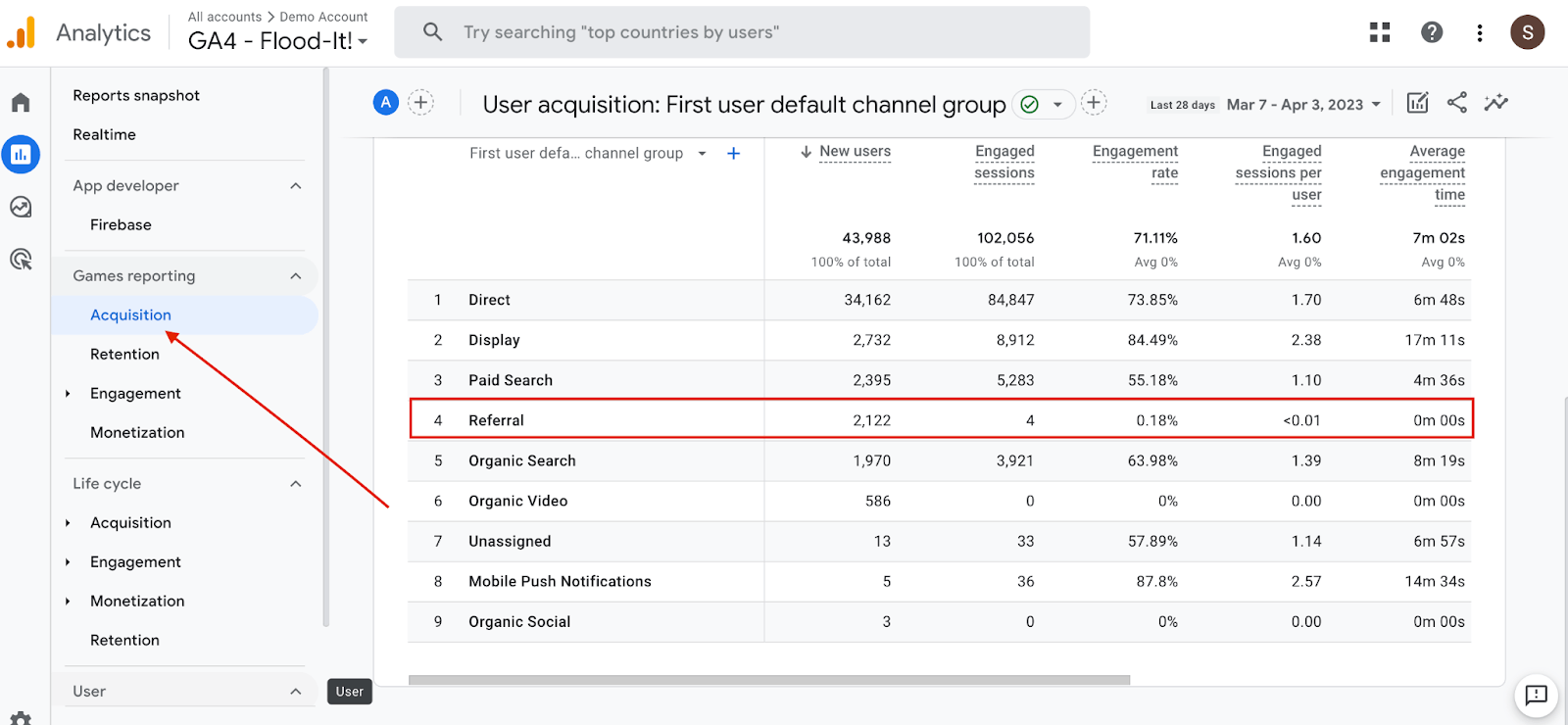
Google Analytics Acquisition page.
You’ll appear more trustworthy
When multiple quality sources are linking to you, search engines interpret that as a vote of confidence — or a testimonial — that other people find your content useful and accurate.
Having backlinks from relevant contributors or those in your area of expertise will help establish your website in your niche. That’s why you need to focus on quality and quantity.
Ryan Robinson, Head of Content at Close, agrees:
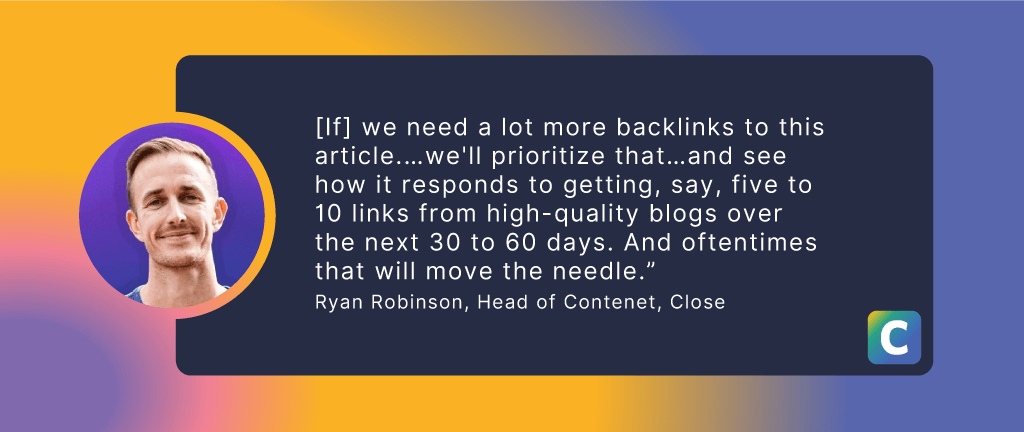
Ryan Robinson, Head of Content at Close, on the importance of quality backlinks.
You can reach a warm audience
Visitors coming to your website from a referral link clicked through for a reason. Perhaps the backlink was for a particular tool or service they’ve been looking for. Or it was directing them to an article you wrote about a related topic.
Either way, the links coming in from this traffic source are warm and already interested in the content you’re providing. Keep them engaged with quality content they can only find on your website.
Final thoughts: How to get good backlinks for your website
Determining how to get good backlinks can be time-consuming, but it’s a plan that fits well with your holistic SEO strategy.
You don’t want to think of gaining backlinks as a separate part of your strategy. Rather, it should work into your existing plan to make content worth linking to and sharing.
Clearscope helps you create excellent content worth linking to. When you use Clearscope for content optimization and keyword research, you’ll better understand your audience’s search intent and can ensure you’re exceeding their expectations.
12 Content Promotion Strategies To Strengthen Your Content Marketing
Content promotion is crucial for your content to reach a wide audience. Let’s explore content promotion strategies to boost B2C and B2B content marketing.
Read moreHow to Improve Your Google Rank: 2023 Best Practices Guide
Our post reviews five best practices to improve your Google rank — from performing technical audits to optimizing page content & promoting brand awareness.
Read moreWhat Is Pagerank? And Does It Matter For SEO Anymore?
Learn what PageRank is and why it still matters for SEO.
Read more